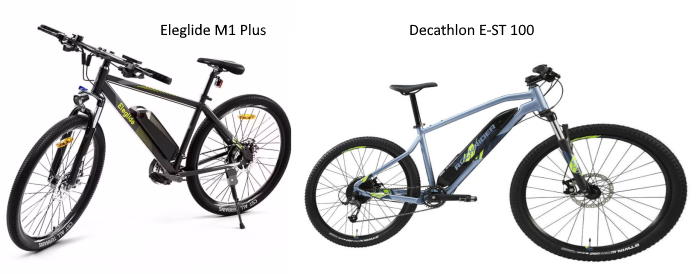Eleglide M1 Plus vs Decathlon E-ST-100
Two perfectly competitive bikes, both capable of long climbs and with good range. This comparison is made on the basis of a real test, over time.

The E-ST-100 is a better known brand but that does not imply greater reliability. The copy of the E-ST-100 that I used experienced power cuts on climbs. After being sent to the workshop and back, the power also cut out on the flat after a few kilometres. As for the exchange or recovery free of charge within 365 days, do not count on it.
I have less perspective on the M1 Plus but all the feedback and online reviews seem to indicate that it holds the road if I may say so...
Comparison of characteristics
| Eleglide M1 Plus | Décathlon E-ST-100 | |
| Power | 250-500 W | 250 W |
| Battery | 12.5 Ah (450 w/h) | 10 Ah (380 w/h) |
| Autonomy | 50-100 km | 45-78 km |
| Max speed | 25-32 km/h to set up | 25 km/h |
| Energy recovery | yes | no |
| Progressivity | yes | no |
| Soft start | yes | no |
| Speedometer and odometer | yes | yes |
| Power modes | 5 | 3 |
| Number of gears | 21 | 7 |
| Hydraulic front suspension | yes | yes |
| Front/rear lights or reflector | yes | no |
| Kickstand | yes | no |
| Weight | 21.7 kg | 22.4 kg |
| Rider size | 165-195 cm | 150-200 cm depending |
| Cost in june 2022 | 800 € | 1100 € |
Description of characteristics
- Wattage: This is the strength of the motor, and it depends on the power assist mode. That of the Eleglide is only 250 Watts in mode 5, but it can be increased to 500 Watts on command, to pass a steep slope.
- Capacity in amps per hour: This is the capacity of the battery and on this depends the autonomy. But the battery technology also influences the autonomy.
- Autonomy: It depends on the level of assistance, the more it is requested and the less the autonomy will be.
- Energy recovery: The battery recharges during descents.
- Progressivity. Assistance expands or shrinks little by little.
- Controlled start. The bike doesn't fire up full engine power on start-up, which avoids a dangerous jump forward in traffic or over the edge of a cliff.
Advantages of the M1 Plus
- The maximum speed allowed for an e-bike to not be considered a moped depends on the country. It is 25 km/h in Europe, but 32 km/h in Canada and USA for example (happy Americans). The M1 Plus allows you to modify it.
- With a front and rear derailleur and 21 speeds, it's easier to tackle steep climbs. This is a mountain capability of this bike.
- The control panel allows you to change the settings.
- The battery recharges in the descents, this is not the case with the E-ST-100.
- Supplied with a kickstand already fitted. The E-ST-100 does not allow mounting of a kickstand.
- The battery is a very common format and can be changed easily or used on several bikes.
- Electric assistance is gradually activated on start-up on the M1. A throttle grip included in the package allows for quicker starts when needed. The general operation is flexible. Conversely, the E-ST-100 has a jerky operation because the assistance stops or activates abruptly.
Advantages of the E-ST-100
- It only has three assistance modes but that's an advantage, because going from mode 1 to mode 3 is faster than going from mode 1 to mode 5 and in town you can change modes often.
- Several sizes of the bike are offered (when available).
- Can be taken already assembled in store if there is one nearby. The M1 Plus arrived from Poland in 4 days and assembled in an hour.
- Original aesthetic, but that's a matter of personal preference.
Conclusion: The ST-100 is elegant and can be obtained already assembled. It is intended for occasional use according to the manufacturer, and the engine must be spared. Its price has increased by 10% in one year.
The M1 Plus is cheaper, more powerful, has more battery life, and is technically more advanced. Its components have already been tested on other bikes and are reliable. However, the battery life deteriorates over time, and you will need to change the battery for long outings.
See also...
A nice electric bike. Elegant, light VAE, usable with or without electric assistance.
An electric bike for less than 1000€






